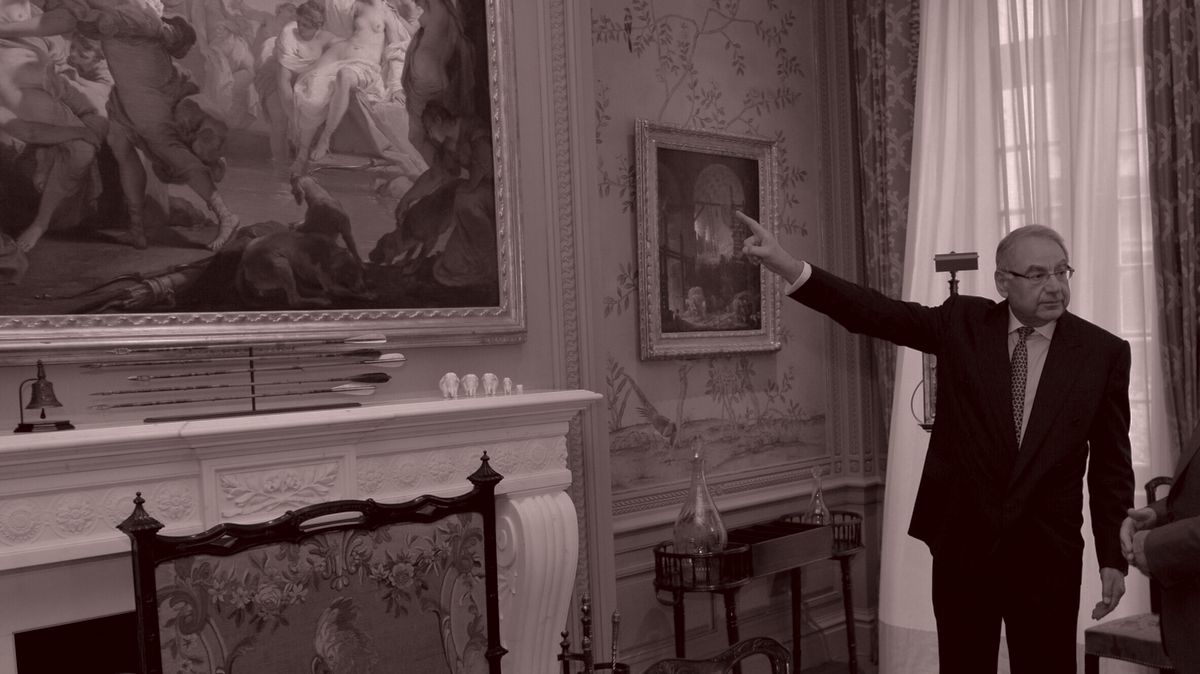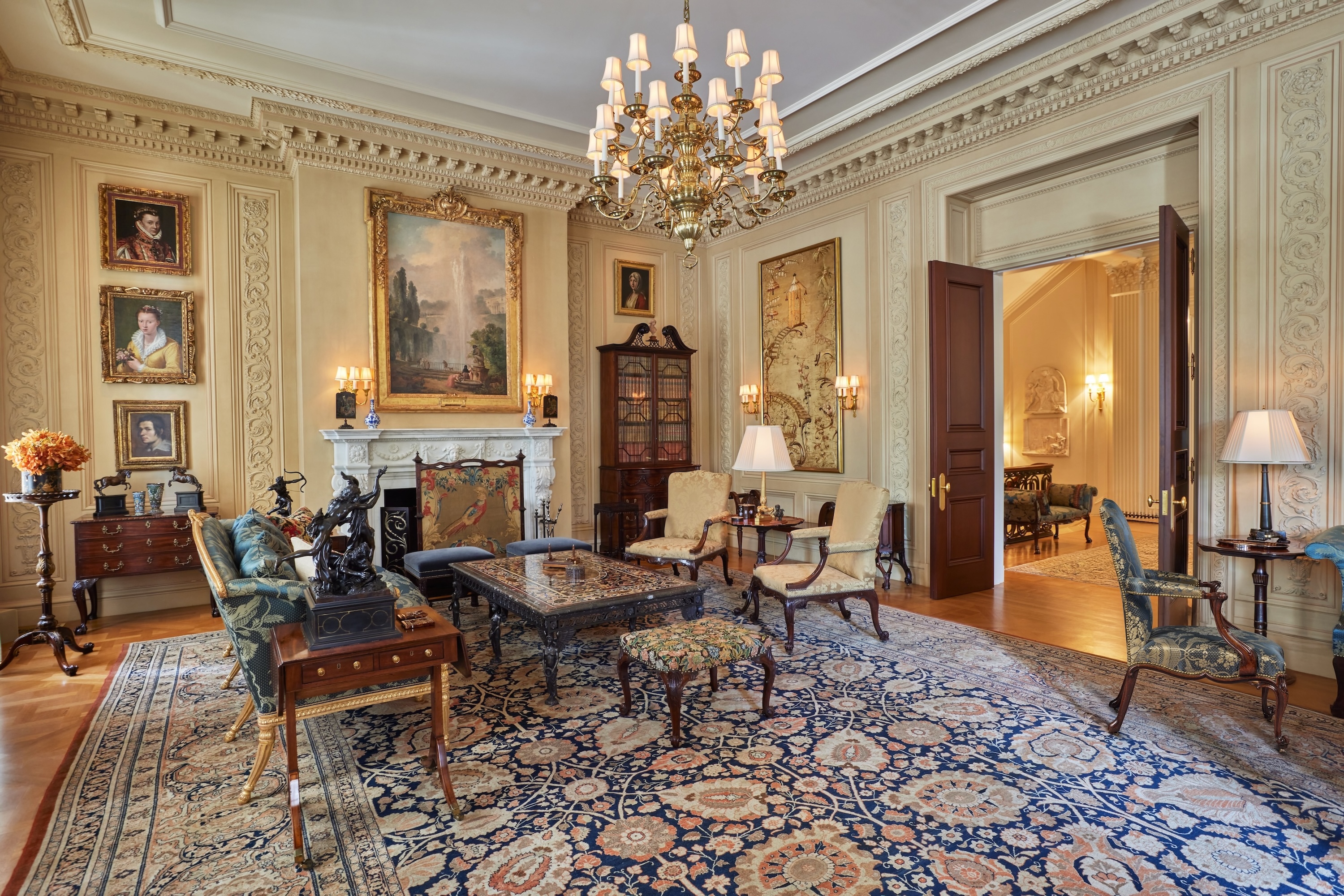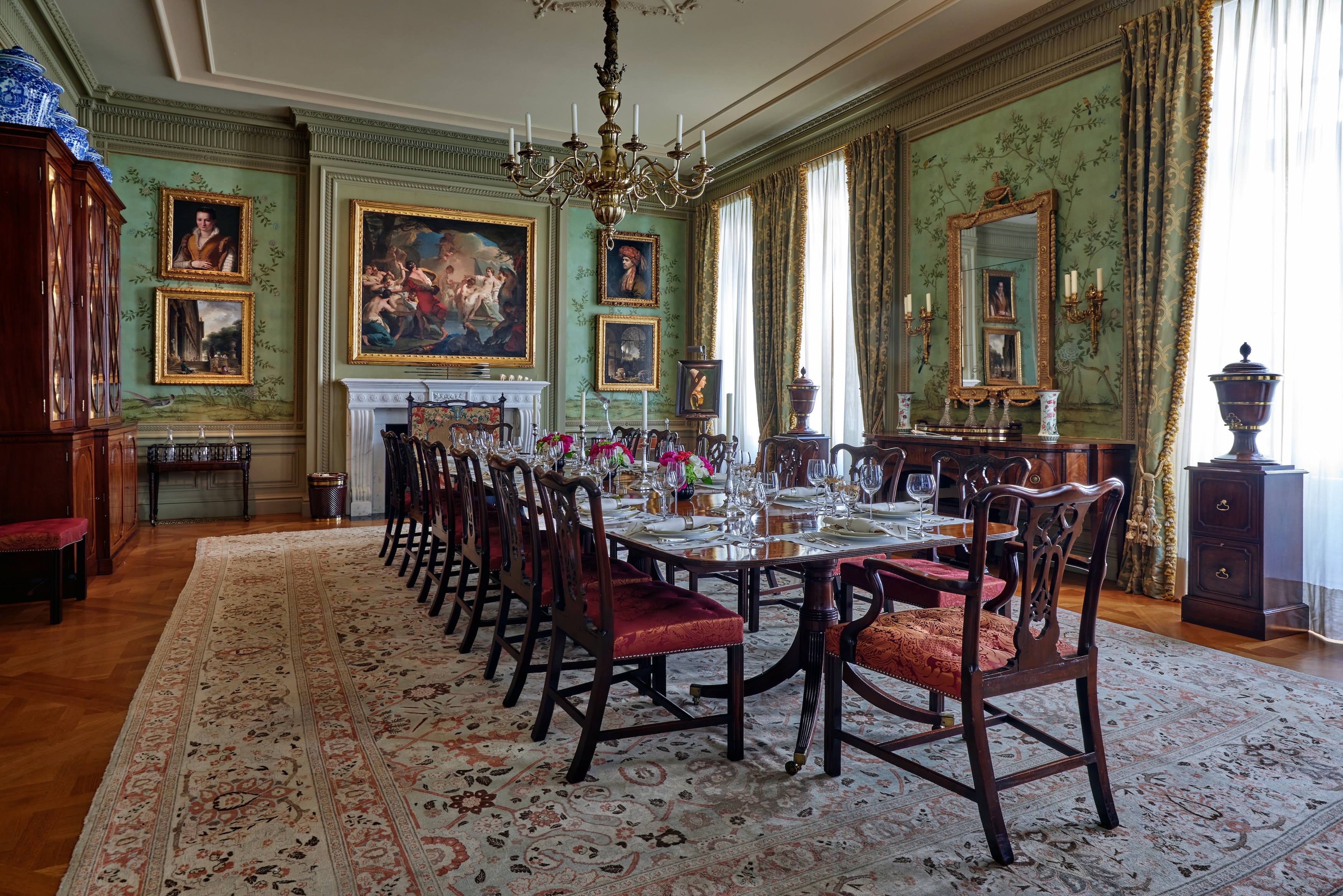Welcome back to Wall Power, your exploration of new art… and old. I’m
Marion Maneker.
In tonight’s issue, Julie Davich has everything on Joopiter’s Pharrell auction and the Old Masters sales, as well as the massive collection of Aso O. Tavitian—a software entrepreneur turned collector on par with Andrew Mellon—over at Sotheby’s.
Take it away, Julie…
|
- To Joopiter and back: Pharrell Williams and Nigo, both multihyphenates in music and fashion, have been friends and collaborators for nearly 25 years. Their most recent partnership was Louis Vuitton’s 2025 menswear collection, presented in Paris a couple of weeks ago. The show took place in the Louvre’s Cour Carrée, where it doubled as the kickoff for Joopiter’s twin auctions,
Nigo Knows and Pharrell Knows Too, closing tomorrow.
|
Louis Vuitton’s 2025 menswear collection, Louvre, Paris. (Photo: Courtesy of Louis
Vuitton)
|
- Spaced
at regular intervals around the circular menswear runway were 24 large vitrines with frosted glass. After the show, as Pharrell and Nigo took their self-congratulatory walk around the stage, the cases became transparent one by one. Each vitrine contained personal items representing a moment in the pair’s shared history—mostly jewelry and clothing, such as the yellow N.E.R.D. trucker hat that Pharrell was often seen wearing in the early 2000s (with stains to prove it). The auction lots stayed on view in the Louvre for two days after the show, and the sales kicked off with a brand-sponsored dinner attended by art stars Takashi Murakami and JR.
The auction is being run by Joopiter, Pharrell’s digital-first auction house, which launched in 2023 with another sale of his personal artifacts, titled
Son of a Pharaoh. That sale made $5.25 million, with items purchased by Kim Kardashian, Drake, and Kid Cudi. Since then, Joopiter has staged 13 auctions, but the cadence and contents have been erratic. One month, it was merch related to the site’s past auctions, priced from $20 to $275; another, it was a single-lot auction of Pharrell’s Richard Mille watch, which sold for $375,000. Now staffed up and backed by Lightspeed Venture
Partners, however, Joopiter plans to keep to a monthly schedule, combining celebrity curators with expanded offerings in postwar and contemporary art and design.
|
A
Christie’s Old Masters Preview
|
The loose theme of this year’s gathering of Old Master works at Christie’s might simply
be the variety of opportunities available to collectors. To wit: a Pieter de Hooch interior scene of card players—complete with the artist’s signature winnowing doorways, opening to the sunshine and the outside world—is one of the dozen or so large genre paintings he made after 1670. The work is estimated at $2.5 million. Another rare opportunity is a
reattributed Frans Hals portrait from 1621—a large Hals for a rather small estimate of $2 million, which may reflect the work’s level of detail and its condition. There’s also a Cranach portrait of the
Duke of Saxony, estimated at only $150,000. Christie’s is offering the work in the first run of lots that it hopes will outperform estimates—a fact that won’t be lost on most buyers.
Then there’s Mattia Preti’s The Liberation of Saint Peter, from 1645, which set a record for the artist at auction more than three decades ago.
Caravaggesque paintings have been in vogue with collectors recently, and this one is estimated at $1.5 million. More daring collectors might be interested in another painting from Naples—Luca Giordano’s Samson and Delilah, circa the 1650s, which is being
offered with a $150,000 estimate. But the work needs to be stripped of its heavy brown varnish to see what the artist actually painted. It’s a gamble, but it might pay off.
Other notable works: François Boucher’s Sleeping Diana,
which was originally made to sit above a door and was later extended by another artist, estimated at $1.2 million; and Dutch mannerist painter Joachim Wtewael’s Adam and Eve, one of the 100 or so paintings by him
that have survived, estimated at $1 million. There’s also a clutch of works being deaccessioned by the Museum of Fine Arts in Boston, which received a large gift of Dutch paintings of such quality that it is now selling some former prizes—for example, Jan Both’s An Italianate landscape with bandits leading prisoners, from around 1650, at a $1 million estimate.
There are also several works by
sought-after painters such as Michael Sweerts, Pieter Claesz, and Caspar Netscher, not to mention some lovely small portraits by Gerard ter Borch II, Parmigianino, and Tiepolo. Finally, a very striking portrait by Élisabeth Vigée Le Brun is on offer for $120,000. It should be worth 10 times that amount. If you get up really, really close, you can see why the price is so
good.
|
And
Now… A Sotheby’s Old Masters Preview
|
There’s a reason why more and more young contemporary art collectors are looking to buy
Old Masters: The art is very good and the prices are often cheaper than contemporary, according to David Pollack, the head of Sotheby’s Old Masters department. As if to make his point, Pollack showed me a profile portrait of a noblewoman by Bernardino de’ Conti, who was part
of Leonardo’s Milan circle in the late 15th century.
The painting is being sold by Jacqui Safra, who purchased it at Christie’s London in 1993 for about $250,000, and who also happens to be embroiled in a lawsuit against that auction house regarding a trove of Albert Einstein letters they sold for him. But don’t let that distract you from
the drama of the painting itself—the subject’s luminous skin contrasts with her exquisitely detailed costume. The painting is guaranteed and carries an estimate of $2 million. Safra is also selling a Courbet and Strindberg in the
same sale.
In the next room is a trove of 22 fresh-to-market paintings from the late Swiss collector Hans König, the first president of the European Fine Art Fair, and his wife, Marion, who
acquired the works in the 1980s and ’90s. There are Dutch, Spanish, Italian, and French works depicting a range of subjects, from still lifes to vedute. The highlight is a 17th century portrait of a well-to-do young girl by Cornelis de Vos, estimated at $600,000 and guaranteed.
Other highlights in the sale include a very early Raphael panel, estimated at $2 million (and also guaranteed), depicting Mary Magdalene—the left side of what once was a small devotional triptych. And there’s a small
Rubens oil sketch of the Annunciation, from 1628-1629, a study for a 10-foot-tall altarpiece that is on view at the artist’s house museum in Antwerp, estimated at $4 million. It last sold at Sotheby’s London in 2014 for $5.4 million. Specialist Daria Foner explained in a
video why Rubens oil sketches are so prized: “They take us into the heart and mind of the painter.”
Finally, given that this is the 250th anniversary of the birth of J.M.W. Turner, I’d be remiss not to mention a lovely little 1841
watercolor of the lighthouses in Le Havre, in the Master Works on Paper sale; it has been in the same family since 1895, and is estimated at $100,000.
|
|
|
Sotheby’s mega auction of the Aso O. Tavitian estate—a treasure trove of aristocratic
objets, Old Master paintings, and English furniture—is a testament to the life of a singular collector. It is also, as Sotheby’s specialist Dennis Harrington puts it, a “history of the antiques trade.”
|
|
|
Aso O. Tavitian, the late software entrepreneur and philanthropist, was the kind of
collector you rarely encounter anymore: self-made but low-profile, and with an omnivorous appetite for aristocratic treasures. The sales of his collection, taking place at Sotheby’s this week, contain more than 800 lots—and that’s just the Georgian mahogany furniture, pietra dura tables, Persian rugs, French silk panels, Baroque bronzes, gilt mirrors, Chinese
export porcelain, silver, and some 40 paintings that he did not donate to the Clark Art Institute in the Berkshires. As dealer Harry Apter wrote in the sale’s catalog, Tavitian was a collector on par with Andrew Mellon, Henry Clay Frick, and J.P. Morgan.
|
Aso Tavitian’s Upper East Side townhouse, New York. (Photo: Courtesy of Sotheby’s)
|
As a patron of the arts, Tativian was more like Mellon, whose collection helped found
the National Gallery in Washington, D.C., than like Frick and Morgan, who turned their homes into museums and monuments to their own treasures. (Like his Gilded Age predecessors, Tavitian kept a seven-story, 35-foot-wide townhouse on East 79th Street, near the Met.) Indeed, Tativian gifted some 330 works of early modern European art, mostly paintings, to the Clark, which was near his country house in Stockbridge and where he served on the board from 2006 to 2012. He also gave $45 million to care
for the collection, endowed a curatorial position to oversee it, and constructed a new wing to house it. “His collection was like family to him,” said Candace Beinecke, Tavitian’s longtime lawyer and friend, who also serves as the head of his foundation and as co-chair of the board at the Met. “He adored every work and wanted to keep part of it together.”
Beinecke worked closely with both the Clark and
Sotheby’s to select the works that would be sent to each. “We focused on making the right selections that would resonate with the whole,” she told me. “The Clark didn’t pick only the most expensive, or the most ‘sexy’ items, you might say. They picked just enough to be truly representative of Aso, his taste and passion.” Tavitian also gifted Francesco Salviati’s Bindo Altoviti, circa 1545, to the Met, and Giovanni Battista Moroni’s Portrait of a
Young Woman, circa 1575, to the Frick, where he was on the board for 12 years.
|
“I Love It! I’ll Take
It!”
|
A Bulgarian-born Armenian, Tavitian escaped the Iron Curtain with his family at the age
of 19, and in 1961 arrived in New York, where he worked as a taxi driver and, in short order, scored a scholarship to study nuclear engineering at Columbia. From there, he and some fellow students founded the software company Syncsort, the major sort program for the IBM mainframe during its heyday. Tavitian later bought out his partners and served as C.E.O. from 1975 to 2008, before selling a large portion of the company. The estate’s share of the proceeds from Sotheby’s sales will benefit his
foundation, which he founded in 1995 to support development in the Armenian region, scholarships for students of Armenian origin, and, of course, the arts.
Tavitian began collecting seriously only in the early 2000s, knowing almost nothing, and it’s remarkable what he accomplished in such a short time. He was passionate, loved the thrill of the chase, and was determined to own something once he decided he
wanted it. “I love it! I’ll take it!” dealer Alexis Kugel recalled him saying, adding: “Aso Tavitian was one of the most intuitive and enthusiastic collectors I ever met.”
Nobody knows why or how Tavitian first became interested in the English furniture that comprises the bulk of his collection, but from the beginning, he worked closely with furniture restorer Peter Holmes, sending
all the items he purchased straight to Holmes’s workshop in London. He never bought something without knowing exactly where he was going to place it.
|
Aso Tavitian’s Upper East Side townhouse, New York. (Photo: Courtesy of Sotheby’s)
|
Dennis Harrington, formerly of Pelham Galleries and now head of English
furniture at Sotheby’s New York, described Tavitian as an “old-fashioned gentleman.” He liked to buy from dealers and at art fairs because “he loved the interaction with people and didn’t mind the retail markup.” Many fondly recall the dinners he arranged annually during TEFAF Maastricht, as well as the dealers’ dinners he hosted every fall in his home. Indeed, among the very first items he purchased were dining room pieces: a set of 18 Georgian carved mahogany
chairs from Mallet, estimated at $80,000, followed by a matching four-pedestal table,
estimated at $30,000. Many of the galleries where he bought such items have since shuttered. “In a way, this collection is a history of the antiques trade,” said Harrington.
Tavitian favored furniture with plain surfaces that showed off the wood—usually mahogany or tropical varieties like satinwood—rather than pieces with elaborate ornamentation such as gilt, lacquer, ormolu, or marquetry. Among the
highlights of the collection is a pair of Chippendale armchairs, circa 1760, commissioned for Dumfries House, and estimated at $120,000. (“Rococo but not excessive,” noted Harrington.) The current estimate is a significant drop from its 2007 purchase price of $769,000 at Christie’s
New York—a testament to the changing tastes and values of today’s collectors. (“English and French furniture used to be the big moneymakers at the auction houses,” Harrington explained.) Only one item in the sale hints at Tavitian’s Bulgarian origins: an Ottoman silver pencase, from the
turn of the 20th century, estimated at $5,000.
Once Tavitian had made good progress in furnishing his homes, he moved on to paintings. That’s when he met George Wachter, Sotheby’s global co-chairman of Old Master paintings, and David Bull, a paintings restorer whom Beinecke introduced him to, and who subsequently helped to guide his acquisitions. (Tavitian’s choice to work
with a restorer, as opposed to an advisor or decorator, shows the importance he placed on quality and condition.) Over the next 15 years, Tavitian’s collection grew to some 200 paintings, about two-thirds of which are portraits. One of the most beautiful paintings in the sale, said Wachter, is
a portrait of Margaret of Austria, painted around 1495 by the Master of the Magdalene Legend and estimated at $1,500,000.
Tavitian was diagnosed with cancer in fall 2019, and caught Covid while at the Maastricht fair in March 2020. He died of septic shock six weeks later, at a hospital in the Berkshires. When the Sotheby’s team was cataloging the collection, they came across an invoice from
Alessandra Di Castro Antichità gallery for a pair of Italian neoclassical marble and gilt candlesticks. They found them still packed in the box they had arrived in from Maastricht.
|
Thanks, Julie. Tomorrow we’re back with an Inner Circle email for all of you art market
addicts. If you haven’t upgraded yet, now’s your chance.
Before you go, let me clarify two things about our recent coverage of Sotheby’s. The first is that I failed to mention, in the brief item on Sunday about the sale of the Mercedes Silver Arrow for $53 million, that the auction was conducted by RM Sotheby’s. Second, the townhall meeting that Sotheby’s held recently was a regularly scheduled
event, and was not organized expressly in response to the announcement of Nathan Drahi’s new role as head of global business development.
Until then,
M
|
|
|
Puck founding partner Matt Belloni takes you inside the business of Hollywood, using exclusive reporting and insight to explain the
backstories on everything from Marvel movies to the streaming wars.
|
|
|
The ultimate fashion industry bible, offering incisive reportage on all aspects of the business and its biggest players. Anchored by
preeminent fashion journalist Lauren Sherman, Line Sheet also features veteran reporter Rachel Strugatz, who delivers unparalleled intel on what’s happening in the beauty industry, and Sarah Shapiro, a longtime retail strategist who writes about e-commerce, brick-and-mortar, D.T.C., and more.
|
|
|
Need help? Review our FAQ page or contact us for assistance. For brand partnerships, email ads@puck.news.
You received this email because you signed up to receive emails from Puck, or as part of your Puck account associated with . To stop receiving this newsletter and/or manage all your email preferences, click here.
|
Puck is published by Heat Media LLC. 107 Greenwich St, New York, NY 10006
|
|
|
|


















